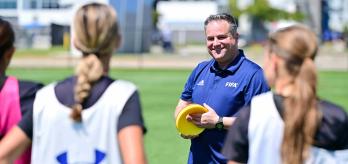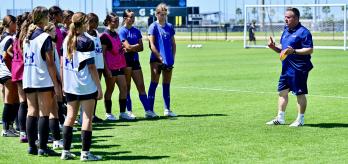A debrief is more than just a wrap-up at the end of training. When done well, it consolidates learning, encourages open communication and helps players take ownership of their development. This article features FIFA Technical Expert Rob Csabai, who demonstrates how structured debriefs, combined with memorable terminology, can make training stick.
Why Debriefs Matter
A debrief is an intentional process that helps players reflect on what they experienced. Research across education and coaching shows that reflection accelerates retention — when players verbalise and revisit what they have learned, the learning “sticks.”
In football, where training is full of dynamic and complex situations, this reflection is critical. Without it, important tactical or technical insights can fade quickly. With it, players develop the ability to recall, recognise and reapply key principles in future matches.
The power of naming concepts
One way to amplify learning and, therefore, the impact of a debrief, is by giving tactical concepts clear, memorable names. Naming creates a shared vocabulary — a shorthand that makes abstract ideas concrete and game-relevant.
In the featured session, the coach introduces the principle of “doing one and a half jobs.” The phrase describes a defensive behaviour: controlling your direct opponent while also positioning to block a passing lane to another attacker. It’s simple, sticky and instantly actionable, giving players a mental anchor they can recall in training and during matches.
A Structured Debrief in Action
The example brings these ideas to life, showing how a coach can guide players from reflection to understanding through a clear, structured process. Each step builds on the previous one:
This structured sequence — reflection, demonstration, summary — ensures players grasp the principle immediately and understand its ongoing value.
Key Take-aways
-
An effective debrief helps players reflect, connect and remember.
-
When paired with guided questioning and memorable terminology, it turns fleeting training moments into lasting development.
-
For coaches, mastering the art of the debrief isn’t an add-on. It’s a core competency that ensures training has a real impact.
Could you apply this?
The phrase “one and a half jobs” works because it’s clear, descriptive and memorable. Naming concepts like this creates anchors players can recall instantly during games and future sessions.
By building a shared vocabulary, coaches make abstract ideas concrete, strengthen recall and connect learning directly to the game.



